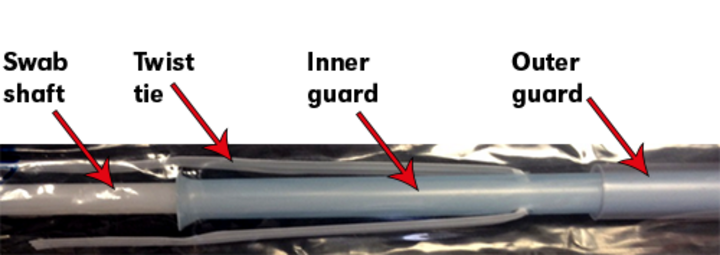Kit contents
- 33-inch double guarded swabs (Jorgensen or Continental)
- Amies transport media tubes (for bacterial culture)
- Virus Transport media (for virus PCR)
- NVDC submission form

Sampling protocol
- Sampled animals should be selected based on clinical signs and ideally in the acute phase of infection. If untreated animals are available, these should be selected first. Three to six (3-6) representative animals should be selected for sampling.
- Restrain the head of the animal in a headgate in processing chute or other immobilization device.
- Remove dirt and debris from exterior nares with a clean cloth.
- Estimate the distance from the nares to the medial canthus of the eye.
- Unwrap the end of the swab with and the twist tie and remove from the swab apparatus (this keeps the guards separate until ready for use).
- Insert the culture swab into the ventral meatus of the nose and advance it the estimated distance from the nostril to the medial canthus of the eye. Put slight pressure downwards and toward the midline of the nose as you advance to ensure the swab stays in the ventral meatus and passes easily. Do not force the swab as this can cause excess bleeding and result in a poor sample.
- Retract the culture swab (not the guard) approximately 1-2 inches.
- Push the inner blue swab guard through the end of the outer guard.
- Push the swab through both guards and beyond the end of the inner guard for approximately 1-2 inches. Vigorously rotate the swab and advance and retract slightly (1/4 inch to 1/2 inch) against the pharyngeal mucosa for 30-45 seconds. You want to ensure an adequate number of cells and exudate are collected in the sample.
- Retract the swab into the inner guard and then retract inner the guard into the outer guard.
- Remove the entire double guarded swab from the nares.
- Remove the inner guard containing the swab from the outer guard.
- Remove the swab from the inner guard.
- Using a clean pair of scissors cut the cotton tipped swab roughly 4-7 inches from the tip. To avoid contaminating the swab do not let it touch any other surfaces. Do not cut the swab too short; short swabs are difficult to remove from the transport media.
- Open the sachet containing the amies transport media (Remel Bactiswab). You can remove and discard the swab with the blue cap included within the packet. Place the swab that you collected in the amies transport media and replace the white cap. Make sure the cotton-tipped swab is fully immersed in the gel.
Repeat the procedure with a different double guarded culture swab in the other nostril. Place the swab in viral transport media and swirl vigorously. Make sure the tube cap is snapped firmly in place with two snaps or they may leak.
NOTE: swabs placed in virus transport media can’t be used for bacterial culture.
- Label all the transport media legibly with the animal’s identification number or name.
- If the samples cannot be shipped immediately, they should be temporarily stored at 4° C in a cooler or refrigerator.
Shipping requirements
- Fill out the NVDC submission form with contact information and requested testing.
—For bacterial pathogens this usually consists of Aerobic culture, antimicrobial sensitivity if required, and PCR for Mycoplasma bovis if suspected.
—Virology testing is the bovine respiratory disease multiplex PCR which includes BVD, IBR, BRSV, and Bovine Coronavirus. - Send the samples overnight with a sufficient number of ice packs to ensure they remain cold during shipment to the laboratory. Please contact the laboratory at 402-472-8470 if you have any questions.